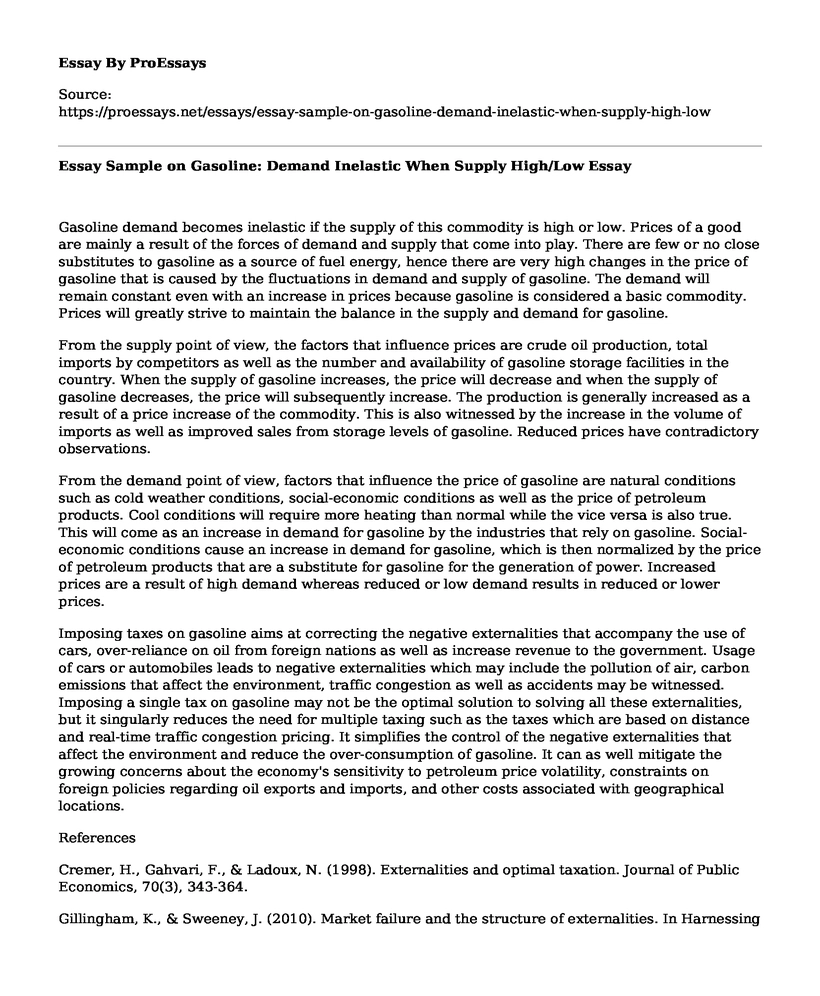Gasoline demand becomes inelastic if the supply of this commodity is high or low. Prices of a good are mainly a result of the forces of demand and supply that come into play. There are few or no close substitutes to gasoline as a source of fuel energy, hence there are very high changes in the price of gasoline that is caused by the fluctuations in demand and supply of gasoline. The demand will remain constant even with an increase in prices because gasoline is considered a basic commodity. Prices will greatly strive to maintain the balance in the supply and demand for gasoline.
From the supply point of view, the factors that influence prices are crude oil production, total imports by competitors as well as the number and availability of gasoline storage facilities in the country. When the supply of gasoline increases, the price will decrease and when the supply of gasoline decreases, the price will subsequently increase. The production is generally increased as a result of a price increase of the commodity. This is also witnessed by the increase in the volume of imports as well as improved sales from storage levels of gasoline. Reduced prices have contradictory observations.
From the demand point of view, factors that influence the price of gasoline are natural conditions such as cold weather conditions, social-economic conditions as well as the price of petroleum products. Cool conditions will require more heating than normal while the vice versa is also true. This will come as an increase in demand for gasoline by the industries that rely on gasoline. Social-economic conditions cause an increase in demand for gasoline, which is then normalized by the price of petroleum products that are a substitute for gasoline for the generation of power. Increased prices are a result of high demand whereas reduced or low demand results in reduced or lower prices.
Imposing taxes on gasoline aims at correcting the negative externalities that accompany the use of cars, over-reliance on oil from foreign nations as well as increase revenue to the government. Usage of cars or automobiles leads to negative externalities which may include the pollution of air, carbon emissions that affect the environment, traffic congestion as well as accidents may be witnessed. Imposing a single tax on gasoline may not be the optimal solution to solving all these externalities, but it singularly reduces the need for multiple taxing such as the taxes which are based on distance and real-time traffic congestion pricing. It simplifies the control of the negative externalities that affect the environment and reduce the over-consumption of gasoline. It can as well mitigate the growing concerns about the economy's sensitivity to petroleum price volatility, constraints on foreign policies regarding oil exports and imports, and other costs associated with geographical locations.
References
Cremer, H., Gahvari, F., & Ladoux, N. (1998). Externalities and optimal taxation. Journal of Public Economics, 70(3), 343-364.
Gillingham, K., & Sweeney, J. (2010). Market failure and the structure of externalities. In Harnessing Renewable Energy in Electric Power Systems (pp. 87-109). Routledge.
Plott, C. R. (1966). Externalities and corrective taxes. Economica, 84-87.
Cite this page
Essay Sample on Gasoline: Demand Inelastic When Supply High/Low. (2023, Mar 27). Retrieved from https://proessays.net/essays/essay-sample-on-gasoline-demand-inelastic-when-supply-high-low
If you are the original author of this essay and no longer wish to have it published on the ProEssays website, please click below to request its removal:
- Report Example on Counterfeit Machinery Components
- Essay Sample on Usage of Concrete
- Essay Sample on Nanotechnology and Robo-Taxis
- Essay Sample on British Petroleum Oil Spill Disaster: 5 Million Barrels of Oil in the Gulf of Mexico
- Oil: A Critical Commodity for Industrial & Construction Needs - Research Paper
- Essay Sample on Autonomous Cars: Engineering Technology Transforms Automobile Industry
- Paper Sample on Architectural Marvels: Design and Engineering in Ancient Rome, Babylon, and Athens







